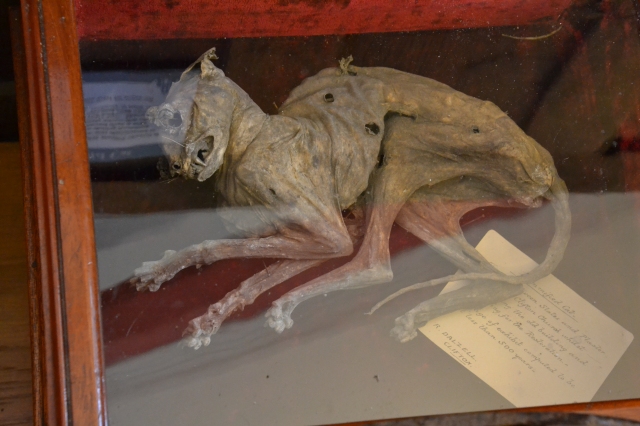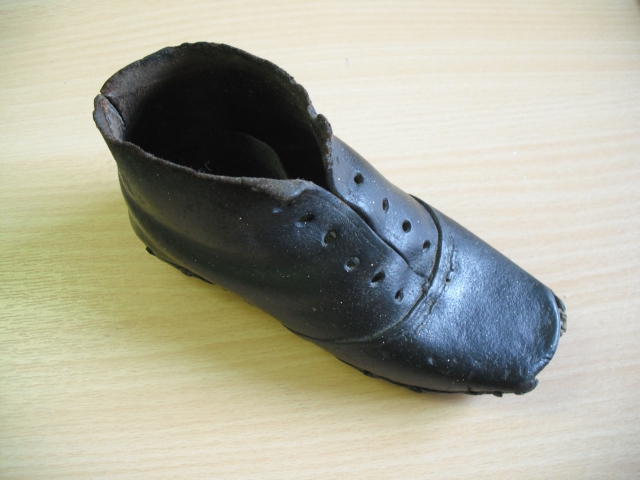A hidden shoe up a chimney breast. A mummified cat in the roof space. A child’s cap in a wall cavity. A horse skull under the floorboards. These are just some of the secret objects people have discovered when renovating their homes – undoubtedly quite surprising finds considering the odd (indeed, sometimes quite disturbing) nature of the objects, coupled with their unusual locations.
 This cat was found in the roof space of a church in Clifton, Cumbria
This cat was found in the roof space of a church in Clifton, Cumbria
 This 18th/19th-century child’s shoe was discovered in the chimney of a house in Ilkley, Yorkshire
This 18th/19th-century child’s shoe was discovered in the chimney of a house in Ilkley, Yorkshire
It’s unlikely that these objects found their way into such places by chance; in most cases it seems quite obvious that they were deliberately concealed. But when, by whom, and why? These are questions that scholars, such as Ralph Merrifield, June Swann, Brian Hoggard, and Timothy Easton have been asking for decades now. Piecing together literary sources, material evidence, and oral history, we’re a little closer to understanding the secret custom of concealment, but much of it still remains a mystery to us.
The Concealed Revealed, which is a strand of the Inner Lives Project, is hoping to continue the search for answers by taking a very broad look at concealed objects. We’re interested in any type of object whatsoever, from the bizarre to the mundane, so long as it was found in an unusual location. Maybe it was secreted away to protect the house from malevolent supernatural forces. Maybe it was hidden as some sort of time capsule or maybe even placed there just as a “bit of a laugh”. Or perhaps it was simply lost. Whatever the possible reasons behind their concealments, we’re interested in hearing about them!
 A large cache of objects, from bottles to pot lids, discovered within the wall of a house in Water End, Hertfordshire
A large cache of objects, from bottles to pot lids, discovered within the wall of a house in Water End, Hertfordshire
We’re mapping concealed objects globally on Historypin, combining historical literary sources with physical finds and – most importantly – with the testimonies of the finders of these objects. Because the main aim of The Concealed Revealed is to consider the custom of concealment from a slightly different angle: to shift focus away from the concealers, to the actual finders.
What do people in the 20th and 21st centuries think when they discover these secret objects in their houses? How do they treat them? How do they feel about them? What do they do with them? What theories do they hold about why the original concealers chose to hide them? Contemporary finders do more than bring these objects to light physically; they shed light on the continuing relationship between objects, the home, and notions of ‘magic’ and the supernatural.
This is why we’re appealing to any finders of concealed objects to contact us. Regardless of whether or not you still have the object in question, regardless of where you are in the world, we’re eager to hear from you. So either comment below or send us an email on c.houlbrook@herts.ac.uk. And if you’re wanting advice on what to do with your concealed object then take a look at the Guidance for Finders section.

Hi,
Congratulations, you have a truly wonderful website.
I came across it as I was trying to understand a finding we have made ourselves.
Inside a partition wall in a house built in London in the 1860s, we found concealed a large wooden box; more like a cupboard than a box, really. And inside it, a beautiful Italian terracotta image (19th century) of the Virgin Mary.
I couldn’t read of similar findings in your blog and I was wondering if you have heard of something like this.
I can provide a picture of the terracotta but unfortunately not of the sites, as the builders took it apart before I could take a picture.
Thanks for your time!
LikeLike
When I did construction work, primarily panelling and dry wall, it was very common to wall up things as we worked. Mostly it was trash we did not want to have to take away. Soda and beer cans, empty grout and adhesive cans, used up caulk tubes, old messed up paintbrushes. Every once in a while something like a tool or box of nails would get walled up unintentionally.
In the South it is not too unusual to find a dead mummified possum when tearing out a wall. They seem to like crawling in there from the attic or crawlspace but they get stuck and die.
LikeLike